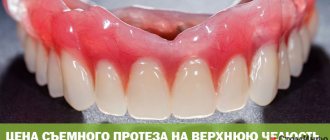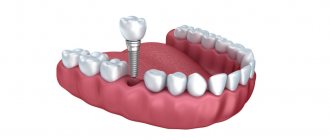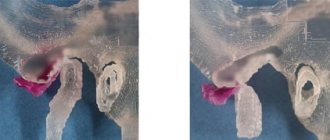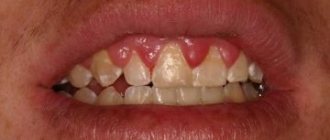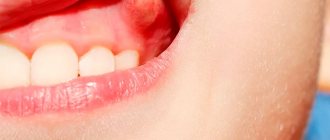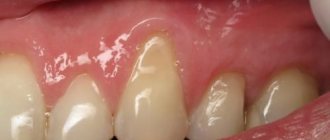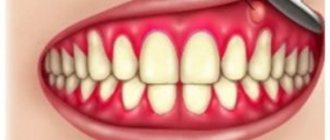Features of treatment
Gum recession is a consequence of impaired circulation of periodontal tissues that nourish bone tissue, resulting in bone atrophy and a decrease in gum level towards the root. The difficulty of treatment is that the loss of soft tissues has an extensive etiology and occurs under the influence of a number of factors:
- inflammatory process and accumulation of plaque and granulation tissue in periodontal pockets;
- improper brushing technique;
- errors in prosthetics;
- mechanical damage, chemical and thermal burns;
- malocclusions, poor-quality orthodontic treatment;
- elderly.
Only in the latter case does recession develop independently, that is, as a consequence of the aging of the body and the mucous membrane in particular. In other situations, the disease is provoked by very specific factors, so successful recovery from gum recession is possible only after identifying and stopping the underlying pathology. For example, in case of periodontitis, it is necessary to remove all dental plaque and carry out anti-inflammatory therapy. If the recession is associated with orthodontics, then it is necessary to correct the bite or replace an incorrectly installed brace system. The same applies to prosthetics: often it is low-quality or incorrectly manufactured dentures that contribute to injury and death of soft tissues.
Diseases in which a lump on the gum does not hurt
There are diseases in which the resulting compaction does not bother the patient with pain. It is because of this that people are in no hurry to see a doctor, which can subsequently complicate treatment. In what diseases does a lump that appears on dental tissue not hurt?
Fistula
If a lump with pus appears in the gum, for the flow of which there is a hole in the gum, we are talking about a fistula. The formation is a growth 3-5 mm in size with a white tip. When the outlet is not blocked by compacted exudate and pus flows freely, such compaction, as a rule, does not hurt. The reason for the formation of a fistula is a complication of periodontitis, in which the tissue grows and becomes infected by accumulated bacteria. Despite the fact that pus periodically flows out and does not accumulate in large quantities, if left untreated, an acute fistula becomes chronic. If the fistula is not treated, there is a risk of infection spreading through the periodontium and tooth loss.
Exostosis
Exostosis is a type of jaw abnormality when the bone protrudes slightly to the surface. Such a lump is hard and painless to the touch, since it is, in fact, a bone or osteocartilaginous growth of a benign nature. The causes of occurrence are hereditary predisposition, congenital pathology or consequences of injury. With such an anomaly, prosthetics are difficult or even impossible: the prosthesis will rub the skin on the bone growth, which can cause injury and infection.
Important! Exostosis is determined by x-rays. The decision to remove is made by the patient, but it is worth considering that such growths can become malignant over time.
Epulis
If a lump appears above the gum, shaped like a mushroom on a stalk, pale pink or red in color, we are talking about epulis - a pathological formation, common mainly in women, and also occurs in children when their first teeth erupt. The reasons for the appearance of epulis are often post-traumatic in nature (large filling, tartar, chips), however, a pathological growth can also appear due to malocclusion, hormonal disorders or wearing low-quality dentures. The symptoms of epulis are similar to those of gingivitis, so for an accurate diagnosis, the doctor uses radiography or a histological test.
Periodontitis
You should think about periodontitis if a lump has formed on the gum - hard to the touch, up to 10 mm in diameter. The causes of inflammation of the periodontal tissues are usually unsealed dental canals and their infection. An abscess forms at the root apex. A characteristic sign of the disease is that when you press vertically on a tooth, pain appears. If the pus has already drained, there may be no pain, but the disease cannot be ignored, as it can lead to tooth loss and further spread of infection.
Attention!
If a seal appears on the gum, under no circumstances should you apply a warm compress or hot rinses: this can aggravate the course of the disease!
Hematoma
A soft-to-touch swelling with watery contents – a hematoma – is formed as a result of tissue injury during tooth extraction. This bump, as a rule, does not require special treatment, dissolving a few days after its appearance.
Do not ignore preventive visits to the dentist.
It is enough to visit a specialist 1 – 2 times a year, which will allow you to promptly identify any dental problem at an early stage of development. This means that its elimination will be quick, easy and without complications.
By clicking the “request a call” button you agree to the personal data processing policy.
Indications for closing gum recession
Elimination of gum recession is necessary when the first visual signs appear, that is, when its free edge drops. In this situation, the only effective way is surgery. Conservative treatment of recession is carried out at the stage when the patient has not yet observed changes in the shape and position of the gingival margin. Analysis of symptoms and diagnostic procedures help identify predisposition to the disease. Increased sensitivity of teeth, inflammation, bleeding, an abundance of plaque and tartar - all these symptoms clearly hint at a pathological process, which sooner or later will lead to more serious complications. Another warning sign is the individual structure of the gums. A narrow and thin layer of attached gum (in simple terms, its base) and a wide root part of the tooth clearly indicate a high predisposition to the development of recession.
WHAT ARE THE CAUSES OF GUM RECESSION?
Gum recession can be caused by many factors, and your dentist can help determine the cause.
- Brushing your teeth too vigorously. If you brush your teeth too vigorously, it can damage your tooth enamel and cause gum recession.
- Poor oral hygiene. Without regular brushing and flossing, the plaque that forms on your teeth hardens and turns into tartar. If left untreated, tartar can lead to gum disease and recession.
- Clenching your jaw too tightly causes teeth to grind and puts more strain on your gums. In severe cases, teeth grinding leads to gum recession.
- Smoking. Smoking increases the risk of gum recession.
- Periodontitis. Periodontitis is a serious gum disease in which the gums no longer adhere tightly to the roots of the teeth, resulting in the formation of periodontal pockets. They develop an infection, damaging the tissue and bone that holds the tooth in place. The tooth begins to loosen. Eventually, periodontitis can lead to tooth loss.
How to stop gum recession?
Therapeutic treatment of gum recession is aimed primarily at eliminating the inflammatory process, normalizing the microflora of the oral cavity, increasing immunity and the body's protective properties.
Therapeutic techniques
- Professional cleaning and sanitation of the oral cavity.
It is used as a preventive measure, and is also the first step in the treatment of the inflammatory process. - Closed curettage of periodontal pockets.
A therapeutic procedure for removing dental plaque in periodontal pockets. - Treatment of gum recession with laser.
Photodynamic laser therapy or laser curettage is performed. - Anti-inflammatory therapy.
The doctor prescribes gels, ointments and rinses (usually topical use), which have antimicrobial and anti-inflammatory properties. - Antibiotic therapy.
- Taking vitamins and supplements.
During recession, vitamins C, D, B9 are prescribed, as well as preparations containing the protein amelogenin, which helps restore soft and hard tissues.
Surgery
- Treatment of damaged tissues and suturing.
The simplest manipulation that is performed during recession, when the gums are damaged as a result of mechanical stress. - Flap surgery.
Gum recession plastic surgery, when donor tissue is taken from a healthy area of the mucous membrane to “close” the missing fragment. Allows you to restore 2-3 millimeters of the level of the mobile gum. The advantage of this technique is the relative speed of the operation and a completely acceptable result. Disadvantages: invasiveness, the need to collect donor tissue and the possibility of rejection. In some situations, the color of the donor tissue may be slightly different, which negatively affects the aesthetics. - Tissue regeneration.
It is carried out using a fibrin membrane - a tissue growth stimulator, which resembles a dense clot and is implanted into the site of recession after preparatory surgical procedures. To produce the membrane, blood is required from the patient, but the healthy area of the gum is not harmed (unlike flap surgery). This technique has a number of advantages: minimally invasive, the possibility of treatment in complex cases, rapid tissue restoration and the absence of the risk of repeated recession. The gums after surgery to eliminate recession look healthy and natural. - Treatment of gum recession with collagen.
Implantation of collagen implants of natural origin for tissue restoration. The implants contain fibrillar protein, which is the basis of connective tissue. Previously, collagen was removed after treatment, but modern implants do not require this and dissolve on their own. This method is especially effective for age-related recession.
Flap operations
What is flap surgery?
What kind
of operation this is, its goals and capabilities is best known to experienced periodontists. Eliminating inflammation is not the biggest problem the periodontist faces.
In severe periodontitis
, the infection destroys the ligament between the tooth root and the bone, resulting in the formation of a periodontal bone pocket filled with granulation infected tissue.
A tooth deprived of support becomes mobile, unstable to loads and eventually falls out. Flap surgery is sometimes confused with open curettage. However, these two methods differ in that during flap surgery, the periodontist has the opportunity not only to clean the bone pockets of granulations and tartar, but also to perform gingivoplasty
.
In flap surgery,
the doctor either removes excess tissue
from the gum
(gingivectomy) or transplants a flap of mucous membrane from another area. Often, a piece of tissue is taken from the mucous membrane of the palate. The flap is cut out and secured with surgical sutures in the desired area. This method of operation has a double result:
- bone pockets are eliminated and filled with an osteogenic preparation
- the contour of the gingival margin is restored (the roots of exposed teeth are covered)
IMPORTANT:
If everything is done correctly, after approximately three weeks, the site of gum surgery cannot be distinguished from any other area of the mucous membrane. Only a qualified periodontist can solve this problem, since periodontal surgery requires special precision, delicacy of execution and the ability to use the latest techniques.
In terms of technique, flap surgery is an indicator of the skill of a periodontist.
Indications for flap surgery.
Flap operations
indicated
for
moderate to severe periodontitis.
- Deep periodontal pockets (more than 6 mm).
- Thinning gum tissue, exposing tooth roots.
- Destruction of bone tissue.
- Inflamed soft tissue is painful and bleeds heavily when eating.
- There is mobility and displacement of teeth relative to their normal position.
IMPORTANT:
This type of surgery has several methods. But in any case, the patient must undergo certain preparation before such a procedure.
Preparation for flap surgery:
- Professional cleaning.
- Sanitation of the oral cavity.
- Splinting of
a mobile group of teeth.
Technique and stages of flap surgery
Flap surgery
performed
in the oral cavity
, usually performed under local anesthesia and lasts from 1 to 3 hours.
There are several methods for carrying out such operations. It can involve one segment or flap surgery in the area of one tooth with partial detachment of the flap.
The doctor will decide on the choice of method after examination and x-ray examination.
The essence of this surgical intervention is that the surgeon receives full open access to the source of inflammation and the ability to eliminate it.
- The doctor makes several incisions on the gum in order to remove the resulting flap and gain access to the apical (root) zone.
- It becomes possible to thoroughly clean and polish the roots, free them from subgingival deposits, infected tissues and granulations with a diode laser.
- Stimulate the process of regeneration of natural bone tissue by using special bone-forming materials as a “refill”. This opportunity has arisen thanks to barrier biological membranes. This is the so-called method of directed tissue regeneration.
- Using biological membranes, the doctor has a unique opportunity to restore damaged areas of bone tissue and return the tooth to its original stability.
- Perform gum surgery. This procedure helps stop the deepening of the gum pocket and helps cover exposed tooth roots, preventing the development of hyperesthesia.
- The operation site is covered with a special bandage.
Advantages of flap surgery:
- stops the development of periodontitis;
- eliminates periodontal pockets;
- reduces atrophic processes in the bones;
- eliminates tooth mobility;
- removes plaque that forms under the gums;
- relieves inflammation;
- destroys the source of infection;
- stimulates regenerative processes in bone tissue.
IMPORTANT:
In our Dentist clinic, during patchwork operations on the gums,
the diode laser
is used as an additional means for sterilizing periodontal pockets and evaporating granulation tissues
Reviews.
Ilya Proskurov I have been receiving treatment and seeing doctors at this clinic for a very long time, almost 20 years!
And I have never regretted it. Truly professional and real doctors! Valentina Vladimirovna and Galina Alekseevna are my leading doctors! For 20 years I have not lost a single tooth, and two weeks ago I also gained two:)) This is all the result of the work of my wonderful doctors! They removed the bridge that was installed 15 years ago (two teeth were missing) and offered implantation. Yanis Yanisovich, an experienced surgeon, a master of his craft. Now I have two more teeth! This is the result I wish for everyone! +7-965- 11XXXXX
I think that the Dentist dental clinic is one of the best! I have completely trusted Galina Alekseevna for many years, I don’t even remember how long I’ve been receiving treatment here. And the clinic itself is cozy, you will always be greeted with a smile and offered tea. We go here with all our relatives. All good!
Price.
The price in Moscow
for flap surgery of periodontal pockets depends on the volume of the upcoming intervention, on the cost of osteoplastic materials.
For operations on the gums, the use of a diode laser has a number of advantages
in terms of
compared to a scalpel or an electrocoagulator, since
,
the wound is completely sterile and for these reasons healing occurs faster and the use of additional antibacterial drugs is not required! The cost is also affected by the additional use of laser treatment, which provides a more effective result and prognosis, shortens the rehabilitation period, and eliminates the development of complications. In terms of technique, flap surgery is an indicator of the skill of a periodontist.
Price
patch surgery at the Dentist clinic
near the Chistye Prudy metro station
is acceptable, given the high quality of the operation, which is guaranteed by the professionalism of specialists and the use of laser techniques. When considering an investment in your own health, consider that treating gum disease is cheaper and better for your health than restoring a tooth lost due to untreated periodontal disease.
So, it is time to look at laser technology with new eyes and apply the treatment that is most in the best interests of patients.
Our patients are always satisfied with the results of our work!
Treatment at home
Treatment of gum recession at home is impossible, since in advanced stages of the disease only surgical intervention can correct the situation. It is not possible to get rid of gum recession with ointments, gels and tinctures: at best, they will help cope with inflammation, but they cannot restore the edges of the gums. Anti-inflammatory therapy is used only as an addition to the main treatment. Folk remedies should be used only on the recommendation of a doctor or as a preventive measure. In the absence of pharmaceutical drugs, folk remedies may provide some benefit. A solution based on soda and salt, propolis extract, decoctions of oak bark, juniper and chamomile are just a small part of the folk recipes that can be used for gum diseases.
What to do to prevent the disease?
Preventive measures do not provide a 100% guarantee that you will never experience gum recession, but following them will help minimize the risks:
- regular and high-quality hygiene;
- professional cleaning of dental plaque;
- using a medium-hard toothbrush and proper brushing technique;
- timely diagnosis of caries and inflammatory processes;
- taking vitamins and amelogenin if there are risks of recession;
- giving up bad habits, especially smoking;
- correction of malocclusions, if you have them.


